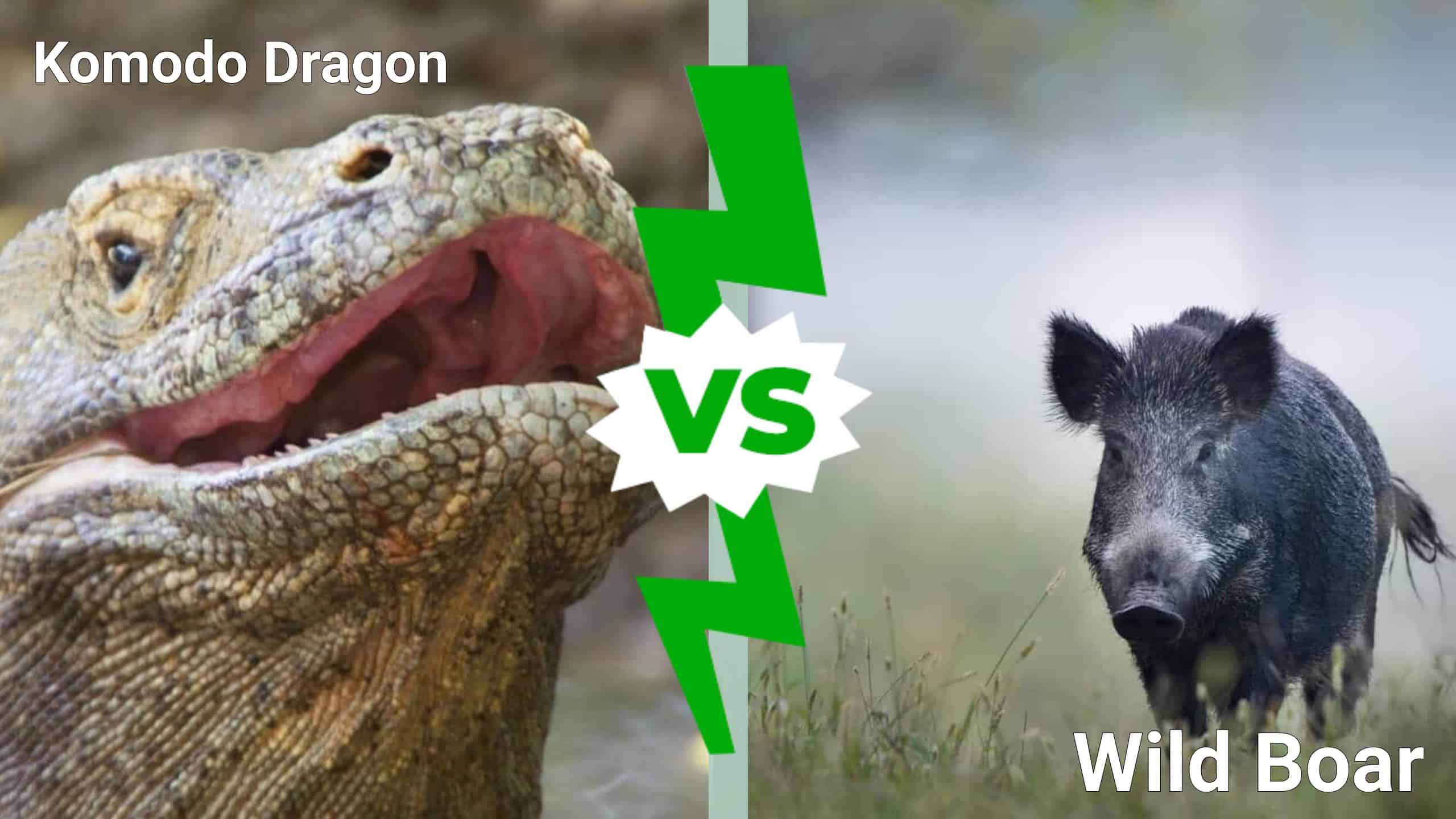Introduction
Did you know that wild boar and Komodo dragons may prey on one another? While wild boars attack and consume juvenile Komodo dragons for food, Komodo dragons may also prey on wild boars, making these two species the perfect match in an epic battle. However, one of these predators maintains greater advantages than the other in a fight. Discover whether a wild boar or Komodo dragon would win in a battle and find out what other prey these creatures attack and kill.

Wild boars and Komodo dragons may share similar habitats, but the distribution of the wild boar is greater than that of the Komodo dragon.
©Budimir Jevtic/Shutterstock.com
Background on the Komodo Dragon
Did you know that Komodo dragons are the largest non-extinct species of lizard in the world? In addition, these creatures are powerful and terrifying predators. Komodo dragons are found primarily on Komodo Island, located near the country of Indonesia. However, Komodo dragons can be encountered on other islands near Indonesia, too.
A characteristic unique to the Komodo dragon is that females may not require a male mate to reproduce. Most Komodo dragon offspring are the result of mating, but some are the result of parthenogenesis. Parthenogenesis occurs when females of a certain species develop a gamete without a mate. Other animals participate in this process, too, such as wasps. However, parthenogenesis primarily occurs within certain invertebrates. Thus, Komodo dragons stand out, as many vertebrates do not experience parthenogenesis.
Komodo Dragon Appearance
Komodo dragons are massive, measuring up to 10 feet in length and achieving a maximum weight of 300 pounds. In addition, the coloration of the Komodo dragon may appear gray, black, or green with some patches of brown, yellow, or white. The skin of these lizards also looks wrinkly or scaly, making the Komodo dragon easy to spot. Furthermore, the teeth of the Komodo dragon are hidden under their gums. Komodo dragons typically have around 60 extremely sharp teeth, called “ziphodonts,” which means “sword-tooth.”
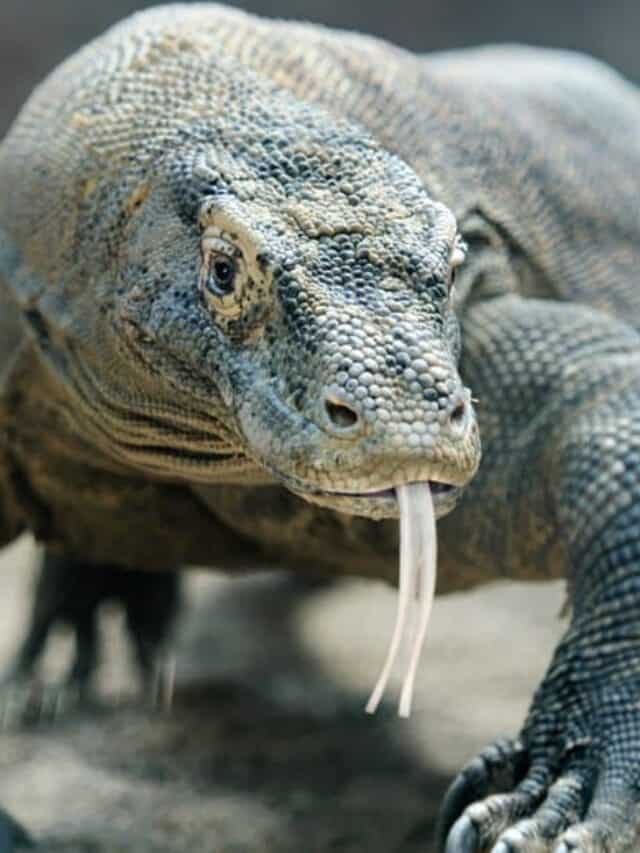
How Does a Komodo Dragon Capture its Prey?
Komodo dragons may capture prey but mainly rely on scavenging to receive their food. Komodo dragons seek out dead animals to consume, but they may attack and kill prey like deer or pigs. In addition, Komodo dragons may engage in cannibalism, where larger members of the species attack smaller individuals. However, some large Komodo dragons could fall prey to other Komodo dragons, too.
Furthermore, Komodo dragons utilize several methods to detect prey. For one, the Komodo dragon has an acute sense of smell, which it uses to find prey that may be dead or alive. In fact, the Komodo dragon can smell an animal carcass from 2.5 miles away. In addition, the eyesight of the Komodo dragon does well at detecting movement. Therefore, moving creatures are easily spotted and attacked by the Komodo dragon.
When a Komodo dragon encounters prey, it usually lurches at it with extreme force and speed. The Komodo dragon bites the prey and shakes it fiercely by moving its neck from side to side. The sharp, curved teeth of the reptile easily latch onto prey and leave considerable damage to flesh and muscle, which results in major blood loss and, in most cases, a state of shock. Komodo dragon claws are also extremely powerful, and these claws can result in more blood loss and damage to prey.
Furthermore, a Komodo dragon bite releases bacteria into prey, which can result in a severe infection like sepsis. In fact, nearly 50 different types of bacteria have been found in Komodo dragon saliva, and seven of these bacterium types are septic. In addition, Komodo dragons may release venom into their prey. Komodo dragon venom reduces blood clotting, causing increased blood loss.
In some cases, larger animals may escape a Komodo dragon attack before infection or death immobilizes them. However, escaping an attack does not signify safety. If a Komodo dragon has already bitten and released venom into prey, infection will result soon enough. While it may take longer for large animals to experience the effects of Komodo dragon bacteria and venom, they will gradually fall victim to these effects and, perhaps, die as a result.
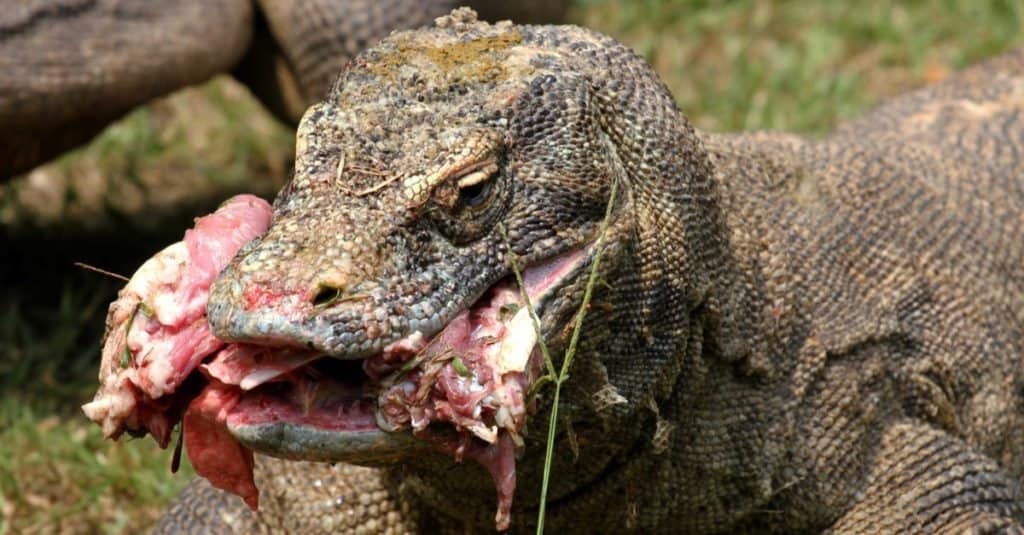
Komodo dragons often feed on animal carcasses because they are scavengers as well as hunters.
©Yudi S/Shutterstock.com
Dangers of Komodo Dragons
Komodo dragons can pose dangers to human life, though instances of Komodo dragon attacks on humans are uncommon. Since these reptiles can attack and kill animals much larger than themselves, they can also kill humans. Over a period of 40 years, Komodo National Park reported a total of 24 Komodo dragon attacks on humans, five of which resulted in death. These attacks may occur in the wild or captivity, so humans should be cautious around this species.
Some dangers of Komodo dragons include their sharp teeth, claws, bite force, bacteria, venom, and overall aggression. The sharp teeth and claws of the species often cause extreme blood loss, especially when blood clotting is halted by venom released into a victim. In addition, the bite force of this reptile lies between 500 and 600 PSI.
Komodo dragons are most dangerous due to their ability to cause severe infection in a victim. The bacteria found in Komodo dragon saliva may cause sepsis, which results in symptoms like shortness of breath, fever, and intense pain in humans. Thus, a human that has been bitten by a Komodo dragon should seek medical attention immediately.
Threats to Komodo Dragons
Komodo dragons are considered an endangered species due to several environmental and anthropogenic factors. For instance, climate change appears to be the biggest threat to Komodo dragon population numbers. Climate change can result in rising sea levels around islands like Komodo Island. As sea levels rise, the total land area on Komodo Island shrinks.
Thus, some researchers believe that between 30% and 70% of the Komodo dragons’ habitat will disappear by 2040 due to rising sea levels. In addition, habitat loss will force Komodo dragons to live closer to one another, narrowing their distribution. As a result, members of the species may begin competing for food and resources, and competition within a species can decrease population numbers significantly.
However, tourism on Komodo Island is one way that awareness of Komodo dragon conservation has increased. Although tourism can harm some species, like whales, tourism of Komodo Island seems mostly positive. Many people visit Komodo Island every year to see Komodo dragons, and Komodo National Park on the island works to protect Komodo dragons and educate visitors. Therefore, tourism on Komodo Island supports the conservation of Komodo dragons through education and generating funds.
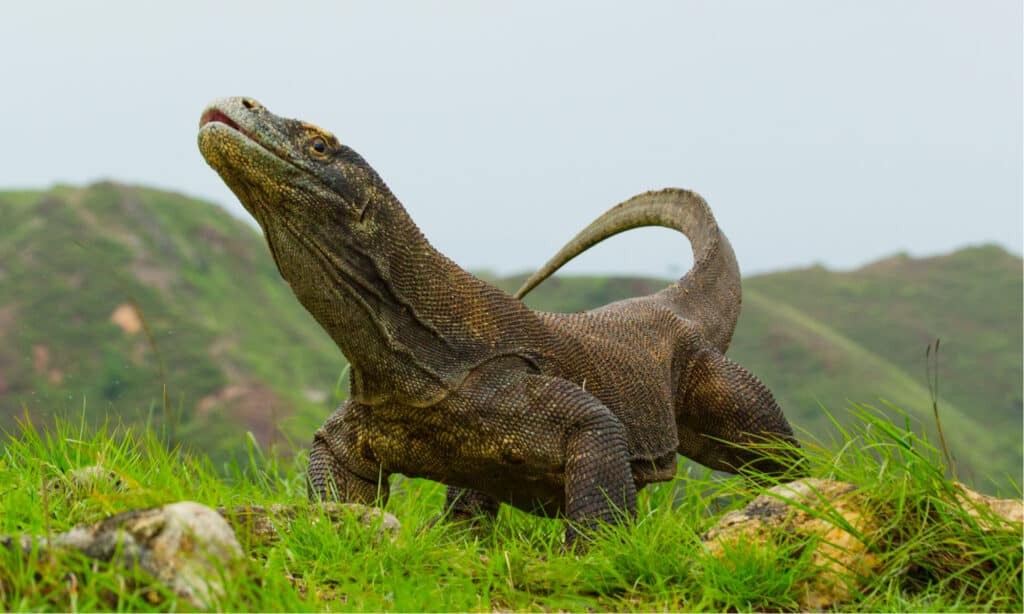
Climate change causes rising sea levels that can lead to habitat loss, which may create highly threatening conditions for Komodo dragons.
©GUDKOV ANDREY/Shutterstock.com
Background on Wild Boars
The wild boar, also known as the European wild boar, holds the title of the largest wild pig on Earth. In addition, these creatures are found across many continents and countries, including Europe, Africa, India, the United States, and more. The habitat of the wild boar includes forests, shrublands, or grassy savannas. However, wild boars may also reside near farmland.
Furthermore, wild boars travel in groups, excluding older male boars, which travel alone. Despite their bulky stature, wild boars are quite fast on land, and they swim well, too. Many people hunt wild boars in places like Europe and India. Due to the wild boar’s speed and strength, they pose quite a challenge to hunters, which makes catching one even more attractive.
Wild Boar Appearance
The coloration of the wild boar appears black or brown, and the hair of the animal looks grizzled with dark and light hairs overlapping one another. Wild boars average around 35 inches in height, but they may exceed four feet tall. In addition, the species ranges between three and 6.6 feet in length, and they record an average weight between 150 and 220 pounds.
Furthermore, wild boars have strong bodies that appear stout but are quite agile. Male wild boars also possess large tusks, which they use to attack prey or defend themselves. Juvenile wild boars typically show lighter hair coloration than their adult counterparts. In addition, these younglings have visible stripes which help camouflage them from predators. Like most juvenile animals born with distinct patterning, the stripes of wild boars fade as they mature.
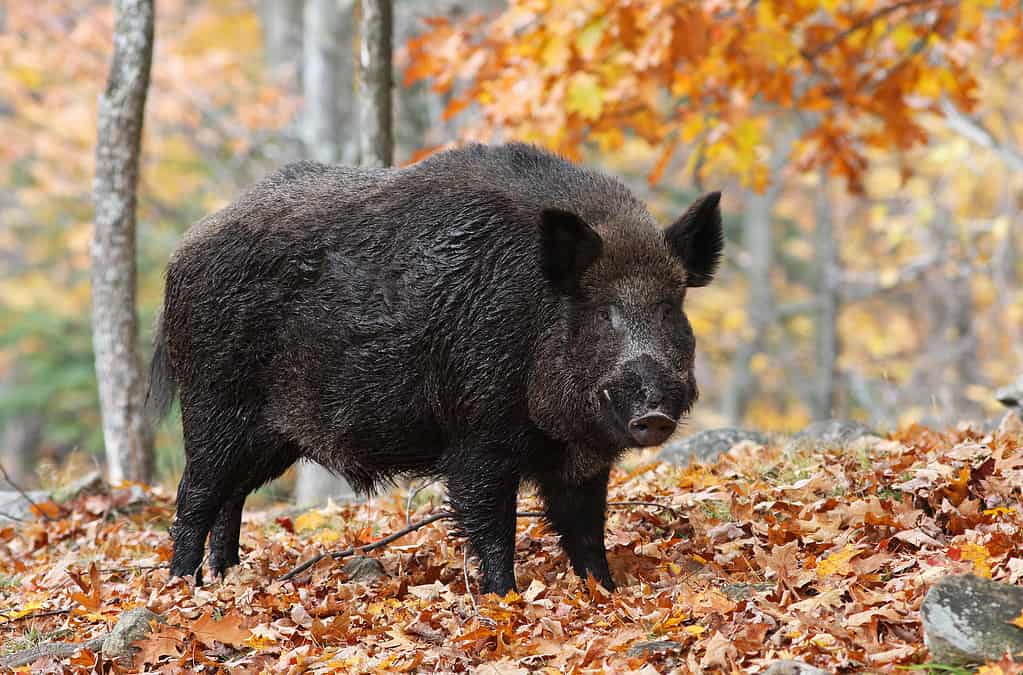
Wild boars possess sharp tusks used for defense or for attacking prey.
©Mircea Costina/Shutterstock.com
How Does a Wild Boar Capture its Prey?
Wild boars have poor vision, so they must use their sense of smell and hearing to detect prey. In addition, wild boars are considered opportunistic predators, meaning they will prey on almost anything that they can find. As omnivores, wild boars may consume both plants and animals, including roots, crops, lambs, rodents, insects, and more.
One way that a wild boar finds food is by rooting and foraging. Wild boars may use their tusks and hooves to burrow into the ground in search of insects or vegetation to eat. In addition, they will tear down crops and other plants to receive sustenance. When a wild boar detects prey, it usually charges at the prey and kills it for food. Since the wild boar will eat anything available to it, few animals and plants are safe from its appetite.
Dangers of Wild Boars
Wild boar attacks on humans are rare, and the few reported attacks usually involve prior provocation. However, wild boars are dangerous in a variety of ways. While the powerful tusks and strength of the wild boar may seem formidable, wild boars carry an invisible threat more dangerous than any feature: disease.
Wild boars carry plentiful amounts of bacteria and a variety of different diseases. Most of these diseases pass through water sources. When a wild boar bathes in a river or lake, it can pass a disease to the water source, and this disease may pass to humans through contact with this water or through animals in the water. Some examples of pathogens carried by wild boars include E. coli, salmonella, swine brucellosis, and more.
If livestock catches a disease or parasites from wild boars, they could die. In addition, livestock can pass these diseases onto humans. When humans receive bacteria or parasites deriving from wild boars, these infectious organisms usually transform into more prominent illnesses like pneumonia or meningitis. Humans that catch a disease from a wild boar are likely to experience symptoms associated with the flu. If left untreated, these illnesses could result in severe symptoms or death.
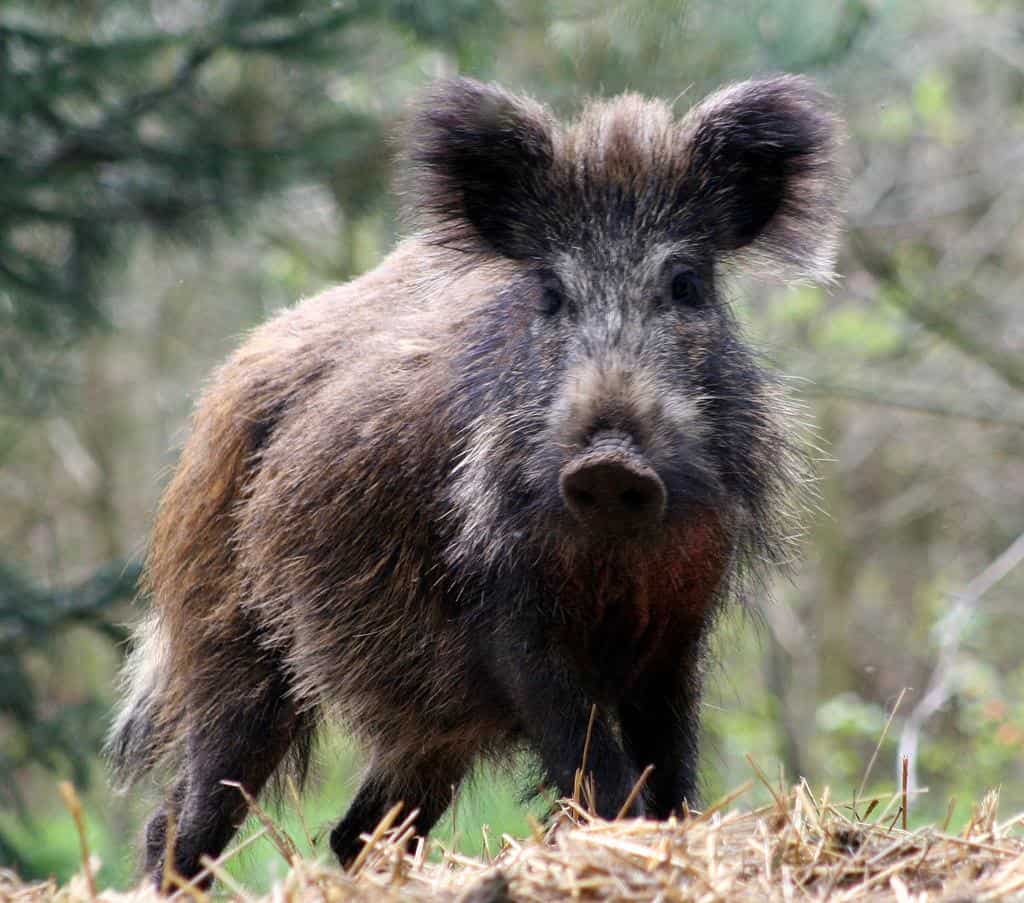
Wild boars carry bacteria and diseases that may be passed to humans through contact with animals, livestock, or water sources.
Threats to Wild Boars
Some predators of adult wild boars include mountain lions. However, juveniles are threatened by a wider variety of predators than adults, such as foxes and coyotes. Another primary threat to wild boars is human disturbance. For instance, humans hunt wild boars across the world, which can threaten the stability of their population numbers.
In addition, wild boars compete with other animals for food and habitat. Deer and wild turkey tend to be the wild boar’s largest competitors, but other game animals compete with the wild boar, too. In addition, late summer and fall mark the seasons in which competition among species is highest, as many desirable foods, such as acorns, become more plentiful.
Komodo Dragon vs. Wild Boar: A Comparison
| Characteristics | Komodo Dragon | Wild Boar |
|---|---|---|
| Size | Up to 10 feet long | Up to 4.1 feet tall Up to 6.6 feet long |
| Weight | Up to 300 pounds | 150 to 220 pounds |
| Features | Curved teeth, sharp claws, bacteria, venom, and a good sense of smell | Grizzled hair, tusks, and rooting behavior |
| Dangers | Serrated teeth, sharp claws, venom, bacteria, and aggression | Tusks, rooting behavior, and disease |
| Threats | Climate change and habitat loss | Predation and competition |
| Predators | Wild boars, snakes, and other Komodo dragons | Mountain lions, foxes, and coyotes |
| Prey | Animal carcasses, rodents, pigs, water buffalo, and nearly any type of meat | Plants, roots, insects, livestock, lambs, and small mammals |
| Habitat | Savanna forests; Komodo Island | Forests, shrublands, grassy savannas, and farmland |
| Dangerous to Humans? | Yes (rare) | Yes (rare attacks; disease is most dangerous) |
| Conservation Status | Endangered | Least concern |
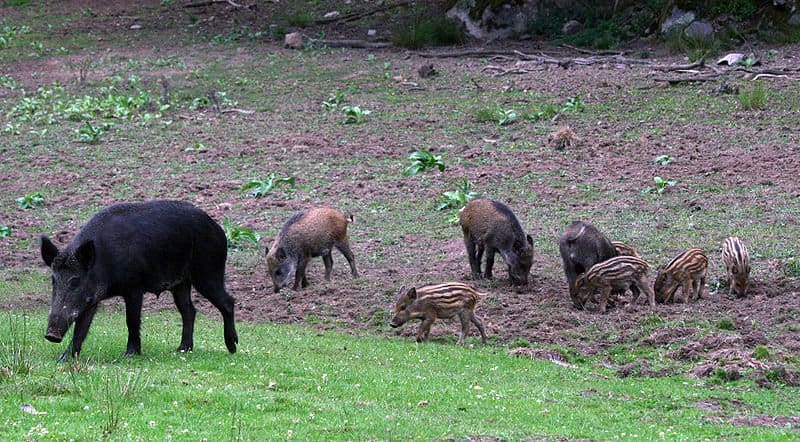
Like Komodo dragons, wild boars will eat practically anything they come across.
©Entheta / Creative Commons – Original
Which Animal Would Win in a Fight: Komodo Dragon or Wild Boar?
In an epic battle between a Komodo dragon and a wild boar, the Komodo dragon would likely emerge victorious. However, the winner of this fight is difficult to determine, as the wild boar is both predator and prey of the Komodo dragon. Wild boars mainly prey on juvenile Komodo dragons, though, as adults are more difficult to subdue. On the other hand, Komodo dragons may attack and consume either juvenile or adult wild boars.
In addition, Komodo dragons are more fearsome than the wild boar. The combination of venom, bacteria, serrated teeth, and incredible strength make the Komodo dragon more prepared for a fight than a wild boar. Wild boars can defend themselves with their tusks, but this one feature would not be enough to ward off the ferocity and menacing features of the Komodo dragon.
The Komodo dragon could attack the wild boar swiftly, biting it and injecting venom. While the venom could take time to fully affect the wild boar, the Komodo dragon’s bite alone would leave considerable damage. If the wild boar were to experience a state of shock due to blood loss, then the Komodo dragon could go in for the kill. Thus, it’s more likely that the Komodo dragon would be crowned the winner of this fight.
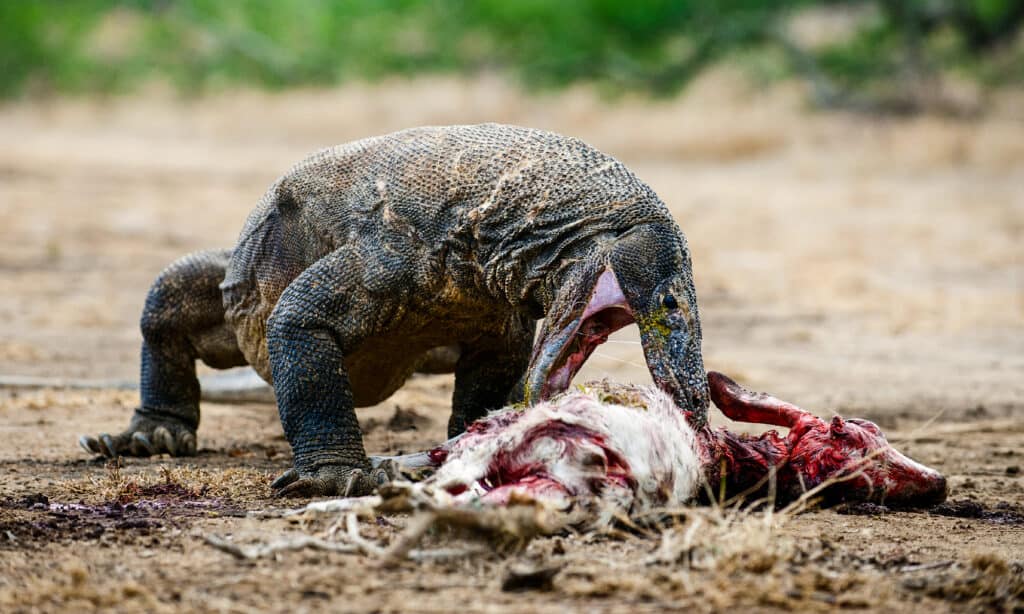
Due to its advantages in strength, bite force, venom, and bacteria, the Komodo dragon would overpower the wild boar in a fight.
©Sergey Uryadnikov/Shutterstock.com
Thank you for reading! Have some feedback for us? Contact the AZ Animals editorial team.

